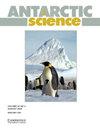南极罗斯海特提斯湾海星Odontaster validus和海胆Sterechinus neumayeri年度活动的延时记录
IF 2
4区 地球科学
Q3 ENVIRONMENTAL SCIENCES
引用次数: 0
摘要
摘要对位于南极洲罗斯海特提斯湾(Tethys Bay)岩石底部、海绵Mycale (Oxymycale) acerata定居的20 m深度的自主照片成像设备拍摄的一年延时图像进行了分析。比较了海星Odontaster validus和海胆Sterechinus neumayeri在海绵和附近岩石底部的丰度和活动的月变化,包括浮冰存在/不存在、温度、盐度和光合有效辐射等环境变量。海胆在夏季和冬季分别在岩石底部和海绵上丰富。从1月到12月,海星在海绵上的个体数量有所减少。两种植物的放牧活动在1 - 4月达到最大值,此时阳光的增加有助于浮游植物的繁殖。冬季是白僵菌和诺氏僵菌的繁殖关键期;虽然红海星在岩石底部维持着寻找食物的活动模式,但海胆却减少了活动。与物理化学传感器相结合的延时监测系统显示出揭示极地环境中物种行为的潜力,有助于阐明面临气候变化的沿海社区的未来变化。本文章由计算机程序翻译,如有差异,请以英文原文为准。
Time-lapse recording of yearly activity of the sea star Odontaster validus and the sea urchin Sterechinus neumayeri in Tethys Bay (Ross Sea, Antarctica)
Abstract One-year time-lapse images acquired via an autonomous photo imaging device positioned at a depth of 20 m in Tethys Bay (Ross Sea, Antarctica) on a rocky bottom colonized by the sponge Mycale (Oxymycale) acerata were analysed. Monthly changes in the abundance and activity of the sea star Odontaster validus and sea urchin Sterechinus neumayeri on the sponge and nearby rocky bottom were compared with respect to environmental variables such as pack-ice presence/absence, temperature, salinity and photosynthetically active radiation. Sea urchins were more abundant on the rocky bottom and sponge during the summer and winter, respectively. Sea stars showed a decrease in the number of individuals on the sponge from January to December. The grazing activity of both species reached its maximum in January–April, when increased sunlight contributed to the phytoplankton bloom. The winter months were critical both for O. validus and S. neumayeri; although the red sea star maintained its pattern of activity on the rocky bottoms in terms of searching for food, the sea urchin reduced its activity. Time-lapse monitoring systems coupled with physicochemical sensors showed potential for revealing species behaviour in polar environments, contributing to the elucidation of future changes in coastal communities facing climate change.
求助全文
通过发布文献求助,成功后即可免费获取论文全文。
去求助
来源期刊

Antarctic Science
地学-地球科学综合
CiteScore
3.60
自引率
6.20%
发文量
42
审稿时长
3 months
期刊介绍:
Antarctic Science provides a truly international forum for the broad spread of studies that increasingly characterise scientific research in the Antarctic. Whilst emphasising interdisciplinary work, the journal publishes papers from environmental management to biodiversity, from volcanoes to icebergs, and from oceanography to the upper atmosphere. No other journal covers such a wide range of Antarctic scientific studies. The journal attracts papers from all countries currently undertaking Antarctic research. It publishes both review and data papers with no limits on length, two-page short notes on technical developments and recent discoveries, and book reviews. These, together with an editorial discussing broader aspects of science, provide a rich and varied mixture of items to interest researchers in all areas of science. There are no page charges, or charges for colour, to authors publishing in the Journal. One issue each year is normally devoted to a specific theme or papers from a major meeting.
 求助内容:
求助内容: 应助结果提醒方式:
应助结果提醒方式:


